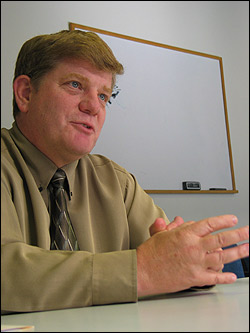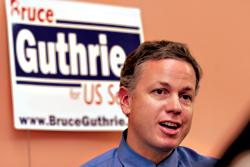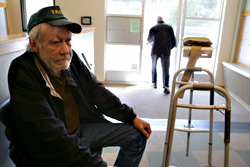You probably know little or nothing of the race for state commissioner of public lands. It’s one of those obscure “down-ticket” races with the curb appeal of used gum, right alongside state auditor and insurance commissioner. Few Washingtonians know that Doug Sutherland, a Republican former mayor of Tacoma, has been running the state’s Department of Natural Resources the past four years.
This year, however, the public lands race has generated the kind of fractiousness and attracted the kind of big money usually found in races for governor and attorney general. Last week, Sutherland’s Democratic opponent, four-term state representative Mike Cooper of Edmonds, began airing television ads—practically unheard of in a lands commissioner race. Sutherland is expected to counter with his own advertising.
While the big-ticket races largely focus on who will do a better job on health care, jobs, or protecting consumers, the public lands job is all about the environment, especially forests. It’s forests and how to manage them that has reignited the age-old Northwestern morality play of loggers versus environmentalists.
The public lands commissioner runs the state Department of Natural Resources. Sutherland agrees that the job is very low profile, even though DNR generates about $250 million a year in revenue, which would make it the 35th largest business in the state if it were a private concern.
The department oversees what is called state trust land, about 5 million acres granted by the federal government in the 19th century. Five million acres is about four times the size of King County. Revenue from the sale or lease of resources on that land goes to fund construction of schools around the state, to the tune of about $100 million every two years. About 1 million acres is comprised of agricultural land in Eastern Washington, leased for cattle grazing and farming. Another 2 million acres are under water and near shore, where the DNR regulates everything from geoduck harvesting and oyster farming to houseboats. The lands commissioner also regulates how timber companies harvest trees on private land.
But it’s the remaining 2.1 million acres, state forest, that generates the most heat. Most of it is dense Douglas fir forest in Western Washington. Timber companies want to log the land and are thrilled with a new “cut plan” enacted last month by the Board of Natural Resources, a panel that oversees the DNR. That plan increases what can be cut to levels not seen for at least 15 years. For the timber industry, the dark days of Sutherland’s predecessor, Democrat Jennifer Belcher, are over. During Belcher’s tenure in the 1990s, timber companies were logging about 400 million board feet a year, even though the DNR had a cut plan that permitted about 600 million board feet. Belcher instituted numerous environmental safeguards that limited what timber companies could effectively log. Under Sutherland’s new plan, the cut level would be back up to 600 million board feet a year.
Sutherland says Belcher was a puppet of environmentalists and that cut levels were so low that the state was not meeting its fiduciary duty to generate revenue from the state trust lands for schools. “I moved DNR into a far better balance” between environmental and timber interests, Sutherland says. He portrays the new cut plan as a moderate measure that contains numerous safeguards for wildlife and water.
Enviros beg to differ. Cooper sees it as akin to “rolling back the roadless rule.” He’s referring to the Bush administration’s decision to reverse some federal forest protection enacted under the Clinton administration in the 1990s. “It reflects his alliance with timber companies to increase logging.”
Environmentalists have already sued the DNR over the new plan, in King County Superior Court, on the grounds that it violates state environmental laws.
Peter Goldman, an environmental lawyer in Seattle, is so mad at Sutherland that he has founded a group called Citizens Protecting Our Water and Forests and is spending $250,000 of his own money, independent of Cooper’s campaign, to unseat Sutherland. It’s one of the largest individual investments in state election history. He says his motivation is to level the campaign playing field between business contributors to Sutherland and the typically less-well-funded enviro community. Cooper himself has raised a relatively modest $250,000.
Timber interests responded by starting their own group, the Committee for Balanced Stewardship, which already has raised more than $300,000, with $90,000 of that coming from Federal Way–based Weyerhaeuser. Sutherland’s campaign itself has raised $450,000, much of it from logging and other resource companies. Combined, that’s almost 60 percent more money backing the commish than he spent in his 2000 race against former Gov. Mike Lowry. That year Sutherland raised $460,000.
Why is big business so interested in the lands commissioner this time? Sutherland says loggers are “scared to death of what’s going to happen” if Cooper is elected and the enviros are back in the driver’s seat of state forest policy. Predictably, enviros are scared to death of what Sutherland will do to the state’s forests. “He’s increasing logging by over 30 percent while saying he’s increasing wildlife,” says Lisa McShane, campaign manager of the Goldman-financed group. She and other enviros say that the increased cut will increase fire risks in Western Washington and destroy water supplies that are surrounded by DNR land.
Cooper says he wants to enact strong protection of old-growth forests on state land and begin an aggressive campaign to create wind farms on state-owned grazing land in Eastern Washington. He says he can get $2,000 an acre from energy companies using the land, as opposed to the minuscule revenue generated by using the land for cattle. “That will be new money for schools,” he says.








